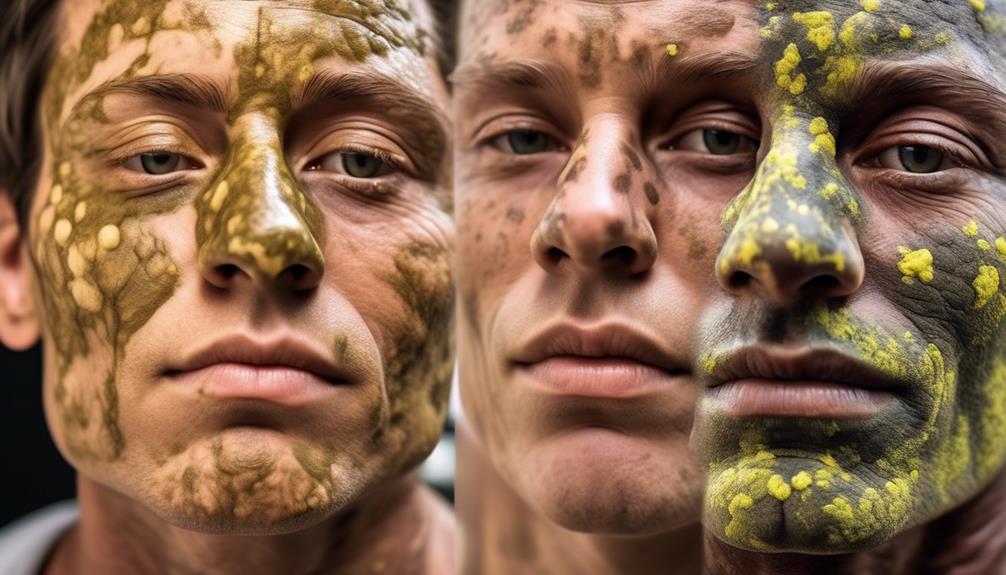They say that beauty is only skin deep, but what if your skin starts to betray you? You may have heard whispers of a phenomenon called kratom hyperpigmentation, a condition where dark patches appear on the skin as a result of using kratom. As you delve into this intriguing topic, you'll discover the mysterious connection between this tropical plant and the melanin-producing cells in your body. Join us as we explore the causes, symptoms, diagnosis, and treatment options for kratom hyperpigmentation, shedding light on this enigmatic skin condition that has left many searching for answers.
Prevalence and Incidence of Kratom Hyperpigmentation
The prevalence and incidence of kratom hyperpigmentation have not been well-documented due to underreporting and limited research. This lack of data makes it challenging to determine the exact frequency of this condition among kratom users. However, based on the available medical literature, kratom hyperpigmentation appears to be a relatively rare adverse effect associated with chronic kratom use.
Reported cases of kratom hyperpigmentation in medical literature are limited, suggesting that it may be an uncommon condition. The few documented cases often describe hyperpigmented patches in a photodistributed pattern, predominantly affecting sun-exposed areas of the body. These findings are consistent with other drug-associated pigmentary disorders.
To establish the true prevalence and incidence rates of kratom-induced hyperpigmentation, further epidemiological studies are needed. These studies should focus on different populations, taking into account factors such as duration and dosage of kratom use, individual susceptibility, and geographical variations. Additionally, the differential diagnosis of hyperpigmentation should be considered, as other factors, such as underlying medical conditions or medication use, can contribute to skin discoloration.
Unfortunately, the lack of research and underreporting of kratom hyperpigmentation cases hinder our understanding of the true prevalence and incidence rates. It is crucial for healthcare professionals to be aware of this potential adverse effect, especially in patients with a history of chronic opioid use or those who engage in kratom consumption. Encouraging individuals to report any adverse effects through online surveys or other data collection methods can help improve our knowledge of kratom hyperpigmentation and its approval status as a drug.
Causes and Risk Factors for Kratom Hyperpigmentation
To further understand the causes and risk factors for kratom hyperpigmentation, it is important to examine the underlying mechanisms and factors that contribute to this condition. Chronic kratom use has been identified as a significant risk factor for hyperpigmentation, particularly when used over a prolonged period of time. The bioactive ingredient in kratom, mitragynine, has been found to increase the production of melanocyte-stimulating peptides, leading to hyperpigmentation.
Sun exposure can also exacerbate kratom-induced hyperpigmentation. This is due to the dopaminergic activity of mitragynine, which can further stimulate melanocyte activity when exposed to sunlight. Therefore, individuals who use kratom and are frequently exposed to the sun may be at a higher risk of developing hyperpigmentation.
Another important risk factor is a history of opiate use. Individuals who transition from opiate use to kratom as a substitute may have an increased risk of developing hyperpigmentation. This suggests a possible association between opioid use and the development of hyperpigmentation.
It is worth noting that the development of hyperpigmentation is not solely attributed to kratom use. Factors such as frequency and duration of use, as well as the dosage, can also play a role. Prolonged and frequent use of kratom, especially at high doses, can contribute to the development of hyperpigmentation.
Symptoms and Clinical Presentation of Kratom Hyperpigmentation

Symptoms and clinical presentation of kratom hyperpigmentation include photodistributed hyperpigmentation, characterized by darkening of the skin in sun-exposed areas such as the arms, face, and forehead. This is a novel cause of photodistributed hyperpigmented patches, and it has been associated with opioid-associated kratom ingestion. The skin darkening in kratom-induced hyperpigmentation may present as blue-gray discoloration, pigment deposition around veins, and occasionally within macrophages in affected areas.
It is important to note that the development of hyperpigmented patches may occur gradually over time. In one reported case, hyperpigmentation developed over a period of 18 months of kratom use. Dermatologists may be the first to recognize kratom use due to the distinctive pattern of hyperpigmentation, and this recognition can guide patients toward appropriate multidisciplinary care.
Diagnosis of kratom-associated hyperpigmentation is primarily based on the patient's history and clinical presentation. It may not be detectable through standard laboratory analysis. Therefore, when patients present with photodistributed hyperpigmentation, especially in the context of known kratom exposures, kratom-associated hyperpigmentation should be considered in the differential diagnosis.
The exact mechanism underlying kratom-associated hyperpigmentation is not well understood. It has been proposed that a simple melanin-drug complex deposition may be responsible for the skin darkening. Further research is needed to elucidate the pathophysiology of this adverse reaction.
Diagnosis and Medical Evaluation for Kratom Hyperpigmentation
When evaluating patients with photodistributed hyperpigmentation, dermatologists play a crucial role in recognizing kratom-associated hyperpigmentation and guiding patients towards appropriate multidisciplinary care. The diagnosis of kratom hyperpigmentation relies on patient history and clinical evaluation rather than standard laboratory tests. Therefore, it is essential for patients to disclose their kratom use to ensure accurate screening.
Here are some key points to consider in the diagnosis and medical evaluation of kratom hyperpigmentation:
- Patient History: Medical professionals should consider kratom use when evaluating patients with hyperpigmentation, itching, or rash. It is important to rule out other potential causes of skin darkening and assess the possibility of kratom-associated hyperpigmentation.
- Clinical Evaluation: Dermatologists examine the distribution of hyperpigmentation patches on the skin, which is often photodistributed. This characteristic pattern can help differentiate kratom-associated hyperpigmentation from other skin conditions.
- Comprehensive Care: Cessation of kratom use may be advised, but evidence of resolution of the skin condition is lacking. Therefore, patients with kratom hyperpigmentation should be referred to addiction specialists for comprehensive evaluation and possible treatment. It is crucial to address both the dermatological and addiction aspects of this condition.
Can Kratom Discount Affect Hyperpigmentation?
Some people believe that using kratom can help with hyperpigmentation, but research on this topic is limited. However, if you are interested in trying kratom, you can find various kratom discount offers online to save money on your purchase.
Can Kratom for Focus Cause Hyperpigmentation?
Some users have reported that long-term use of kratom benefits for concentration may lead to hyperpigmentation. While more research is needed, this potential side effect should be considered before using kratom to increase focus. It’s important to weigh the potential risks alongside the benefits when using kratom for cognitive enhancement.
Treatment and Management Strategies for Kratom Hyperpigmentation

Treatment and management strategies for kratom hyperpigmentation involve a multidisciplinary approach to address both the dermatological and addiction aspects of the condition. The first step in management is the cessation of kratom use, although evidence regarding the resolution of the skin condition is lacking. It is important to recognize that kratom hyperpigmentation may be a sign of underlying kratom use disorder, and patients should be referred to an addiction specialist for further evaluation and possible treatment.
The treatment of kratom hyperpigmentation focuses on the management of the skin manifestations. Hyperpigmented patches, often photodistributed, are the hallmark of this condition. Topical treatments such as hydroquinone, retinoids, and corticosteroids have been utilized with variable success. However, it is important to note that these treatments primarily address the cosmetic aspect of the condition and do not target the underlying cause.
Differential diagnosis is crucial in the management of kratom hyperpigmentation. Other causes of skin darkening, such as hormonal disorders, nutritional deficiencies, and drug-induced pigmentation, should be ruled out. Histopathological examination of skin biopsies may reveal findings such as melanin-drug deposition and dermal mucin, providing valuable diagnostic information.
In addition to the dermatological management, addressing the addiction risks associated with kratom use is essential. This involves a comprehensive treatment plan that may include counseling, behavioral therapy, and support groups. A multidisciplinary approach, involving dermatologists, addiction specialists, and mental health professionals, is crucial in providing holistic care to individuals with kratom hyperpigmentation.
Further research is needed to better understand the relationship between kratom use and skin abnormalities. Additionally, the development of effective treatment strategies for kratom hyperpigmentation is an area that requires attention. By focusing on both the dermatological and addiction aspects of this condition, patients can receive comprehensive care to improve their overall well-being.
Frequently Asked Questions
How Do You Treat Drug Induced Pigmentation?
To treat drug-induced pigmentation, there are various options available. Topical treatments, such as skin lightening creams and natural remedies, can be used to reduce the appearance of hyperpigmentation. Laser therapy, chemical peels, and microdermabrasion are effective in targeting the pigmented areas. Consulting a dermatologist is crucial for personalized treatment plans. Vitamin C supplements can also help improve skin health. Additionally, lifestyle changes, like wearing sunscreen and using camouflage makeup techniques, can prevent further pigmentation. It's important to explore the best treatment approach with a healthcare professional.
Does Hyperpigmentation Go Away?
Hyperpigmentation can vary in its ability to fade, depending on factors such as its cause and your skin type. In some cases, it may go away naturally over time, especially with the adoption of certain lifestyle changes and the use of topical creams. However, for more persistent cases, laser treatments may be necessary. It's important to remember that hyperpigmentation can have psychological impacts, and seeking professional advice from a dermatologist can help address these concerns and provide tailored treatment options.
Does Kratom Increase Serotonin or Dopamine?
Does kratom increase serotonin or dopamine? Kratom's bioactive compound, mitragynine, affects neurotransmitters like serotonin and dopamine in the brain. It has been shown to have dopaminergic and serotonergic activity. These effects can potentially modulate serotonin and dopamine levels, which may play a role in kratom's impact on mood and brain chemistry. Further research is needed to fully understand the relationship between kratom and these neurotransmitters, as well as its potential role in mood disorders and dopamine regulation.
Is Hyperpigmentation a Skin Condition?
Yes, hyperpigmentation is a skin condition characterized by darkening of certain areas of the skin. It can be caused by various factors such as sun exposure, hormonal changes, inflammation, and certain medications. There are different types of hyperpigmentation, and it can affect people of all skin tones. Preventive measures include wearing sunscreen and protective clothing, avoiding excessive sun exposure, and maintaining a good skincare routine. Medical treatments and natural remedies are available to help manage hyperpigmentation. It's important to consult a dermatologist for personalized advice.









